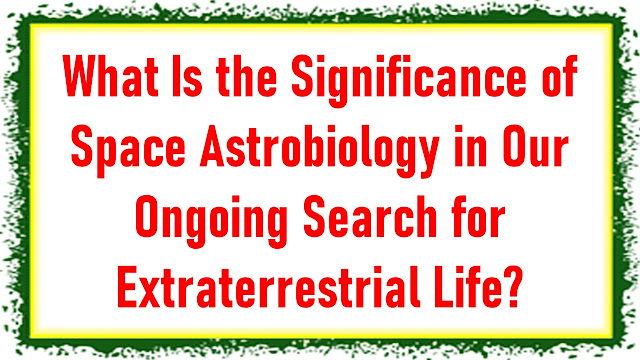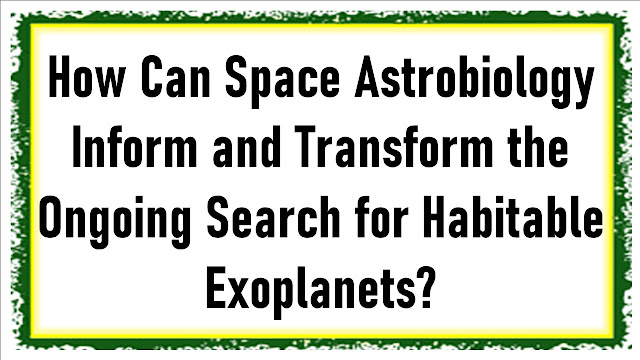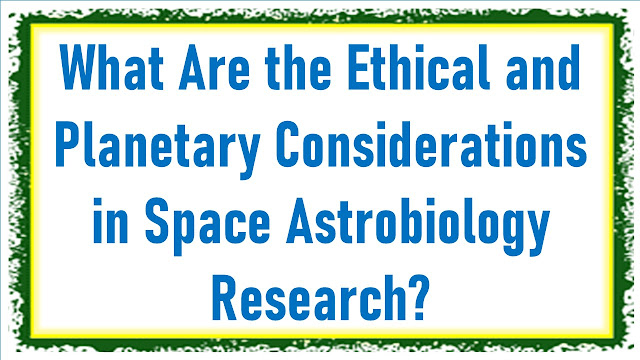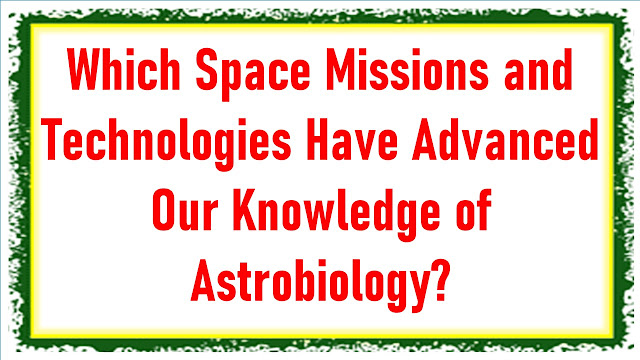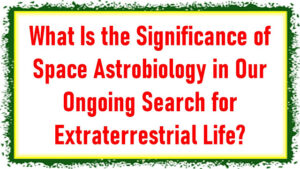
Introduction.
In this article, I’ll delve into the captivating realm of space astrobiology and its profound significance in our relentless quest for extraterrestrial life. As we gaze upon the vast cosmic expanse that surrounds us, the question of whether life exists beyond our home planet continues to captivate the collective imagination of humanity. Space astrobiology, at the intersection of astronomy, biology, and planetary science, is the discipline dedicated to unraveling this age-old mystery.
The exploration of space astrobiology not only fuels our curiosity about life’s potential existence elsewhere in the universe but also carries profound implications for our understanding of life’s origins and adaptability. Through this exploration, we are not only searching for cosmic neighbors but also striving to comprehend the fundamental principles that underpin life itself, shedding light on the diversity and resilience of living organisms and offering insights into the conditions necessary for life to flourish, be it on distant exoplanets or within our solar system’s celestial bodies. In the pages that follow, we will embark on a journey to uncover the multifaceted significance of space astrobiology and its role in expanding the frontiers of our cosmic knowledge.
- Origins of life: Understanding how life could arise elsewhere.
- Habitability factors: Identifying conditions for life on other planets.
- Extremophiles: Studying life’s resilience in extreme environments.
- Biosignatures: Detecting signs of life on distant celestial bodies.
- Astrobiology missions: Exploring other planets and moons for life.
- Implications for humanity: The societal impact of finding extraterrestrial life.
Origins of Life: Understanding how life could arise elsewhere.
Space astrobiology plays a pivotal role in unraveling the mysteries of life’s origins and its potential existence beyond Earth. The significance of this aspect lies in its potential to shed light on the fundamental question of whether life is a unique phenomenon limited to Earth or a more universal occurrence in the cosmos. By examining the conditions and processes that could give rise to life on other celestial bodies, scientists hope to expand our understanding of the possibilities for extraterrestrial life.
One of the key areas of study in this regard is the exploration of extremophiles on Earth, organisms that thrive in extreme conditions such as high radiation, extreme temperatures, or acidic environments. Understanding how these extremophiles survive and adapt provides insights into the adaptability of life forms in space, where conditions can be harsh and hostile. This knowledge is crucial in assessing the potential habitability of other planets and moons.
Additionally, space astrobiology investigates the chemistry of the cosmos, looking for organic molecules and prebiotic compounds that could serve as the building blocks of life. By examining celestial bodies like comets, asteroids, and even the atmospheres of distant planets, scientists search for clues about the chemical processes that could lead to the emergence of life.
Habitability Factors: Identifying conditions for life on other planets.
Another critical aspect of space astrobiology is the identification of habitability factors on celestial bodies beyond our planet. This aspect is significant because it helps us pinpoint the places where life as we know it might exist and guides our search for extraterrestrial organisms.
Space astrobiologists study a range of factors that influence a celestial body’s potential to support life, including the presence of water, the availability of essential elements and compounds, temperature, atmospheric conditions, and protection from harmful radiation. The goal is to identify environments that are conducive to life as we understand it or to broaden our definition of habitability based on the potential adaptations of alien life forms.
For instance, the discovery of liquid water on Mars and the subsurface oceans on moons like Europa and Enceladus has raised the possibility of habitable niches beyond Earth. The study of extremophiles on Earth informs our understanding of life’s adaptability and provides insights into how organisms might survive in extreme environments on other worlds.
Extremophiles: Studying life’s resilience in extreme environments.
Extremophiles are organisms on Earth that thrive in extreme conditions, such as extreme temperatures, high radiation, high-pressure environments, and acidic or alkaline settings. The study of extremophiles is crucial in space astrobiology for several reasons.
Firstly, extremophiles provide insights into the adaptability and resilience of life forms in the face of extreme environmental challenges. By understanding how these organisms survive and even thrive in harsh conditions, scientists can infer how life might persist on other celestial bodies with extreme environments, such as the subsurface oceans of icy moons or the acidic clouds of Venus.
Secondly, extremophiles offer valuable analogs for potential extraterrestrial life. By studying organisms that can exist in conditions previously thought inhospitable to life, researchers can expand their search criteria and broaden the definition of habitability. This is particularly relevant when exploring celestial bodies with conditions that are very different from Earth’s.
Biosignatures: Detecting signs of life on distant celestial bodies.
Biosignatures are clues or indicators that suggest the presence of life, either currently or in the past, on a celestial body. These signs can take various forms, and their detection is a critical aspect of space astrobiology.
The significance of biosignatures lies in their potential to provide compelling evidence of extraterrestrial life. They help scientists identify locations where life may have existed or may still exist, even when direct observation of organisms is challenging. Biosignatures can include chemical compounds, patterns of isotopes, the presence of organic molecules, and physical structures that are unlikely to form without biological influence.
One well-known example of biosignatures is the detection of methane in the atmosphere of Mars. While methane can have abiotic sources, its presence, in combination with other data, has raised intriguing questions about the possibility of microbial life beneath the Martian surface.
Astrobiology Missions: Exploring other planets and moons for life.
Space astrobiology is closely tied to missions and exploration efforts aimed at searching for life beyond Earth. The significance of these missions lies in their potential to directly investigate and gather data from celestial bodies suspected to have the conditions necessary for life.
For example, NASA’s Mars rovers, such as Curiosity and Perseverance, are equipped with instruments designed to search for signs of past or present life on the Martian surface. These missions have already provided valuable data on Mars’ geology, climate history, and potential habitability, and they continue to explore regions with high astrobiological potential.
Similarly, missions to icy moons like Europa and Enceladus have been proposed to study the subsurface oceans and assess the possibility of life thriving in these hidden environments. These missions aim to analyze plumes of material ejected from these moons, potentially containing valuable information about their internal conditions.
Implications for Humanity: The societal impact of finding extraterrestrial life.
The search for extraterrestrial life and the findings of space astrobiology have profound implications for humanity as a whole. Discovering life beyond Earth would be a transformative scientific and cultural milestone with several significant implications: Firstly, it would answer one of humanity’s most profound questions: Are we alone in the universe? This revelation could inspire a sense of unity and purpose among people worldwide, highlighting the interconnectedness of all life forms and encouraging international collaboration in the exploration of space.
Secondly, the discovery of extraterrestrial life could stimulate scientific advancements and technological innovations. The need to study and understand alien biology and ecosystems would drive research in numerous fields, including biology, chemistry, and astronomy, leading to breakthroughs that could benefit society on Earth.
Thirdly, the societal impact includes philosophical and ethical considerations. Questions about the nature of extraterrestrial life, its rights, and our responsibilities towards it would arise. Ethical dilemmas related to potential contamination of alien environments and the implications of contact with intelligent extraterrestrial civilizations would require careful consideration.
Conclusion.
I hope this exploration into the significance of space astrobiology has shed light on its pivotal role in our quest to uncover extraterrestrial life. In our ongoing search, space astrobiology has emerged as a multifaceted discipline, not only expanding our understanding of the potential habitability of other celestial bodies but also challenging our very definition of life itself. As we delve deeper into the cosmos, we find that astrobiology not only offers a glimpse into the conditions necessary for life to exist beyond Earth but also helps us appreciate the fragility and uniqueness of our own planet.
Furthermore, the interplay between astrobiology and space exploration accelerates technological advancements, paving the way for future missions to Mars, Europa, and other celestial bodies where life might lurk. The knowledge gained from these endeavors can not only reshape our understanding of biology but also inspire a sense of wonder and curiosity about the universe we inhabit. In conclusion, space astrobiology is a beacon of hope, guiding us in our relentless pursuit of the profound question: are we alone in the cosmos? It signifies a promising path forward, offering the potential to uncover life’s mysteries beyond our home planet and enriching our perspective of the universe.






